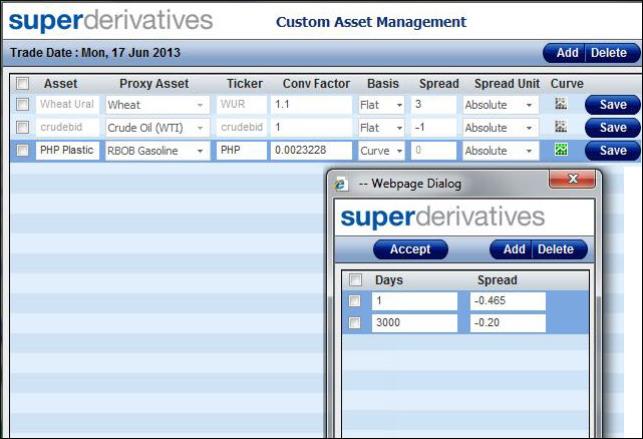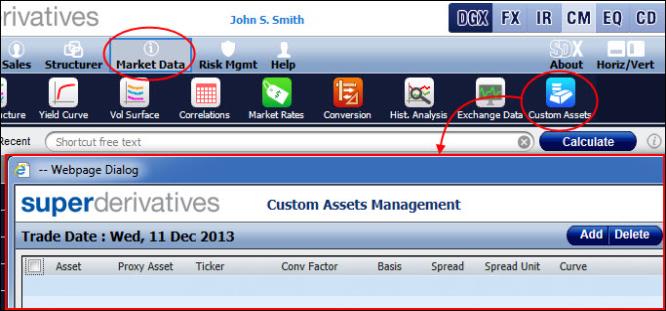
In the Custom Asset Management window you can manage your own custom assets that can then be used in SD products.
Each custom asset is linked to (or based on) on an existing official benchmark asset, known as the proxy asset. You then adjust the price of the proxy asset to suit the custom asset by including one or both of the following elements:
You can define a conversion factor, which lets you cover differences in prices.
You can define a spread, which lets you take into account any differences in costs, such as storage and transportation.
When defining a spread, you can choose to define a fixed (or flat) spread or a time-dependent spread by creating a curve. Furthermore, the spread can be a negative value, if you think that the costs incurred will be less than those of the proxy or if you think that the convenience yield will go up. The convenience yield may go up, for example, if the underlying is wheat and there is a sudden drought leading to an increased demand for wheat. In that case, the difference between the first purchase price of the wheat versus the price after the drought is the convenience yield.
The price of the custom asset is calculated by multiplying the future price of the proxy asset by the conversion factor and then adding the spread.
Once created and saved into the system via the Custom Asset Management window, a custom asset behaves like any other commodity asset and it is available to all users in your company. That is, it is available in the list of commodities in the Commodity dropdown list (under the Custom Assets dropdown list) and its term structure can be viewed in the Term Structure window.
|
|
The Custom Assets dropdown list in the Commodity dropdown list only appears if there is at least one custom asset defined |
For more details on how to manage your company's custom assets click here.
Why is it useful to be able to create a custom asset? You may want to hedge yourself against a particular asset which is not officially traded in the market. Although this asset may be similar to an existing benchmark asset, it may be different due to a number of factors, including any or all of the following—a particular underlying quality, its localization, or a different scale of costs (such as storage, transportation, etc.).
Or alternatively, you may want to hedge yourself against an asset which is officially traded but to which you want to automatically add your incurred costs.
Being able to create a custom asset using SD's intuitive functionality lets you tailor the asset to match your view of the market. This way you can easily manage different grades or variations of commodities that are not officially traded.
This is useful for a corporate treasurer, physical trader, cooperative or bank.
A bank can use this functionality, for example, to adjust the asset price as and when it wants. For a physical trader or corporate treasurer, for example, this functionality can be used:
To create a new asset based on an existing asset.
For example, you may want to create a new asset for wheat farmed in the Urals that is not officially traded. Using this functionality you can link this asset to one of the existing wheat assets, e.g., Milling Wheat, adjusting the price relative to the price of the proxy asset using the conversion factor and the spread.
To let you adjust the price of an officially traded asset to take your own costs into account. For example, you want to hedge yourself not only for the price of the asset but also against the storage costs, etc.
To create a new asset that is a specific grade of residual fuel quoted as a fraction of an existing crude oil asset minus a specific basis spread.
Examples of custom assets can be seen in See "The Custom Asset Management Window".

Figure 1: The Custom Asset Management Window
You manage your custom assets using the Custom Asset Management window.
Once you have accessed the window you can then:
Create a custom asset.
Edit an existing custom asset.
Delete a custom asset.
Access a custom asset.
|
|
Once you have made any changes to the custom assets via the Custom Asset Management window, to see the changes in the Commodity list in the pricer you must first refresh the current window. |
Accessing The Custom Asset Management Window
You access this window via the ribbon bar using the Market Data button tab > Custom Assets button (as seen in See "Accessing the Custom Asset Management window ").

Figure 2: Accessing the Custom Asset Management window
You create custom assets using the Custom Asset Management window.
Once you have created them:
To see the additions in the Commodity list in the pricer you must first refresh the current window.
You can then subsequently edit them or delete them in the Custom Asset Management window.
To create a custom asset:
| 1. | After accessing the Custom Asset Management window, click Add. |
| 2. | Define a name for the new custom asset in the Asset column. |
| 3. | In the Proxy Asset dropdown list select the existing asset that will be linked to the new asset. |
| 4. | Define the new asset's ticker, or shortcut, in the Ticker column. |
| 5. | Optionally define the conversion factor. You do this in the Conv Factor column. |
| 6. | Optionally define the spread. |
To do this in the Basis column define if you want to define a flat spread or a spread curve. If you choose Flat, then you must define a value in the Spread column; if you choose Curve then you must define a curve by clicking the icon in the Curve column.
In addition in the Spread Unit column you must indicate if you want to define the spread as an absolute value or as a percentage.
| 7. | To save the defined custom asset click Save. |
Once you have created a custom asset, you can then edit its conversion factor, spread, basis (whether the spread is flat or taken from a curve), the spread unit and the curve itself.
You do this in the Custom Asset Management window.
To edit a custom asset:
| 1. | After accessing the Custom Asset Management window, edit the relevant custom asset. |
| 2. | Click Save. |
After creating a custom asset, you can then delete it if necessary via the Custom Asset Management window.
Once you delete a custom asset, it is no longer displayed in the Custom Assets dropdown list in the Commodity dropdown list.
To delete a custom asset from the list of assets:
| 1. | After accessing the Custom Asset Management window, check the custom asset you want to delete. |
| 2. | Click Delete and then click Yes. The custom access is deleted. |
Once you have created a custom asset, it is then accessible to all users in your company via the Commodity dropdown list.
To access a custom asset in the pricer:
| 1. | In the pricing page click the Commodity dropdown list. |
| 2. | Select Custom Assets and then the relevant custom asset. |
rib